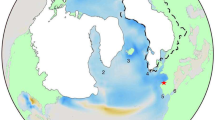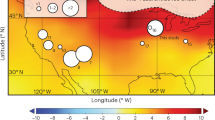Abstract
During the last deglaciation, warming over Antarctica was interrupted by a return to colder conditions from about 14,540 to 12,760 yr ago. This period, known as the Antarctic Cold Reversal, is well documented in Antarctic ice cores1, but the geographic extent of the cooling throughout the Southern Hemisphere remains unclear2. Here we use 10Be surface-exposure ages from two glacial moraine sets from the Southern Alps, New Zealand, to assess whether the glacier advance was associated with the Antarctic Cold Reversal. We find that widespread glacier resurgence culminated 13,000 years ago, at the peak of Antarctic cooling. Subsequent glacier retreat in the Southern Alps coincided with warming in Antarctica. We conclude that the climate deterioration associated with the Antarctic Cold Reversal extended into the southern mid-latitudes of the southwestern Pacific Ocean. We suggest that the extensive cooling was caused by northward migration of the southern Subtropical Front, and concomitant northward expansion of cold Southern Ocean waters.
This is a preview of subscription content, access via your institution
Access options
Subscribe to this journal
Receive 12 print issues and online access
$259.00 per year
only $21.58 per issue
Buy this article
- Purchase on Springer Link
- Instant access to full article PDF
Prices may be subject to local taxes which are calculated during checkout



Similar content being viewed by others
References
Lemieux-Dudon, B. et al. Consistent dating for Antarctic and Greenland ice cores. Quat. Sci. Rev. 29, 8–20 (2010).
Broecker, W. S. Does the trigger for abrupt climate change reside in the ocean or in the atmosphere? Science 300, 1519–1522 (2003).
Anderson, B. & Mackintosh, A. Temperature change is the major driver of late-glacial and Holocene glacier fluctuations in New Zealand. Geology 34, 121–124 (2006).
Schaefer, J. M. et al. High-frequency Holocene glacier fluctuations in New Zealand differ from the northern signature. Science 324, 622–625 (2009).
Putnam, A. E. et al. In situ cosmogenic 10Be production-rate calibration from the Southern Alps, New Zealand. Quat. Geochronol. 5, 392–409 (2010).
McGregor, V. R. Holocene moraines and rock glaciers in the central Ben Ohau Range, South Canterbury. J. Glaciol. 6, 737–748 (1967).
Denton, G. H. & Hendy, C. H. Younger Dryas age advance of Franz Josef Glacier in the Southern Alps of New Zealand. Science 264, 1434–1437 (1994).
Turney, C. S. M. et al. Redating the advance of the New Zealand Franz Josef Glacier during the Last Termination: Evidence for asynchronous climate change. Quat. Sci. Rev. 26, 3037–3042 (2007).
Calvo, E., Pelejero, C., De Deckker, P. & Logan, G. A. Antarctic deglacial pattern in a 30 kyr record of sea surface temperature offshore South Australia. Geophys. Res. Lett. 34, L13707 (2007).
Lamy, F. et al. Antarctic timing of surface water changes off Chile and Patagonian ice sheet response. Science 304, 1959–1962 (2004).
Barker, S. et al. Interhemispheric Atlantic seesaw response during the last deglaciation. Nature 457, 1097–1102 (2009).
NGRIP Members. High-resolution record of Northern Hemisphere climate extending into the last interglacial period, Nature 431, 147–151 (2004).
Rasmussen, S. O. et al. A new Greenland ice core chronology for the last glacial termination. J. Geophys. Res. 111, D06102 (2006).
Stocker, T. F. & Johnsen, S. J. A minimum thermodynamic model for the bipolar seesaw. Paleoceanography 18, 1087 (2003).
Broecker, W. S. Paleocean circulation during the last deglaciation: A bipolar seesaw? Paleoceanography 13, 119–121 (1998).
Crowley, T. J. North Atlantic deep water cools the Southern Hemisphere. Paleoceanography 7, 489–497 (1992).
Liu, Z. et al. Transient simulation of last deglaciation with a new mechanism for Bølling–Allerød warming. Science 325, 310–314 (2009).
Vellinga, M. & Wood, R. A. Global climatic impacts of a collapse of the Atlantic thermohaline circulation. Clim. Change 54, 251–267 (2002).
Sikes, E. L. et al. Southern Ocean seasonal temperature and Subtropical Front movement on the South Tasman Rise in the late Quaternary. Paleoceanography 24, PA2201 (2009).
Denton, G. H. et al. The last glacial termination. Science 328, 1652–1656 (2010).
Toggweiler, J. R., Russell, J. L. & Carson, S. R. Midlatitude westerlies, atmospheric CO2, and climate change during the ice ages. Paleoceanography 21, PA2005 (2006).
Bard, E. & Rickaby, R. E. M. Migration of the subtropical front as a modulator of glacial climate. Nature 460, 380–384 (2009).
Harrington, H. J. Glacier wasting and retreat in the Southern Alps of New Zealand. J. Glaciol. 2, 140–144 (1952).
Anderson, R. F. et al. Wind-driven upwelling in the Southern Ocean and the deglacial rise in atmospheric CO2 . Science 323, 1443–1448 (2009).
Noone, D. & Simmonds, I. Sea ice control of water isotope transport to Antarctica and implications for ice core interpretation. J. Geophys. Res. 109, D07105 (2004).
Anderson, R. F. & Carr, M. E. Uncorking the Southern Ocean’s vintage CO2 . Science 328, 1117–1118 (2010).
EPICA Community Members. One-to-one coupling of glacial climate variability in Greenland and Antarctica, Nature 444, 195–198 (2006).
Monnin, E. et al. Atmospheric CO2 concentrations over the last glacial termination. Science 291, 112–114 (2001).
Skinner, L. C., Fallon, S., Waelbroeck, C., Michel, E. & Barker, S. Ventilation of the deep Southern Ocean and deglacial CO2 rise. Science 328, 1147–1151 (2010).
Acknowledgements
We thank the Gary C. Comer Science and Education Foundation and the National Oceanographic and Atmospheric Administration for support. D.J.A.B. was supported by Foundation for Research, Science and Technology contract CO5X0701. C.S. was supported by the Swiss National Fund proposal no. 200020-105220/1. This work was partially supported by National Science Foundation awards EAR-0746190 (to R.C.F.), 074571, 0936077, 0823521 (to M.R.K., J.M.S. and G.H.D.). We thank the staff of the Center for Accelerator Mass Spectrometry at Lawrence Livermore National Laboratory for their devoted and meticulous work. R. F. Anderson, W. S. Broecker, R. B. Alley, J. D. Hays, G. R. M. Bromley, B. L. Hall, and U. Ninnemann contributed helpful insights. We thank B. Lemieux-Dudon for providing the most recent ice-core chronologies. H. and R. Ivey of Glentanner Station graciously allowed us access to the Birch Hill moraines. We thank the Department of Conservation—Te Papa Atawhai, te Rünanga o Ngäi Tahu for access to the Macaulay valley and inner Birch Hill moraines. This is LDEO contribution no. 7396.
Author information
Authors and Affiliations
Contributions
A.E.P. helped design the project, conducted field work and laboratory analyses, and wrote the paper. G.H.D., J.M.S. and C.S. helped design the project and participated in the field work. D.J.A.B. and B.G.A. conducted geomorphic mapping. R.S. carried out laboratory work. A.M.D. participated in the field work. R.C.F. conducted AMS analyses. G.H.D., D.J.A.B., J.M.S., M.R.K., and C.S. helped write the paper.
Corresponding author
Ethics declarations
Competing interests
The authors declare no competing financial interests.
Supplementary information
Supplementary Information
Supplementary Information (PDF 1912 kb)
Rights and permissions
About this article
Cite this article
Putnam, A., Denton, G., Schaefer, J. et al. Glacier advance in southern middle-latitudes during the Antarctic Cold Reversal. Nature Geosci 3, 700–704 (2010). https://doi.org/10.1038/ngeo962
Received:
Accepted:
Published:
Issue Date:
DOI: https://doi.org/10.1038/ngeo962
This article is cited by
-
Antarctic evidence for an abrupt northward shift of the Southern Hemisphere westerlies at 32 ka BP
Nature Communications (2023)
-
Glacier fluctuations in the northern Patagonian Andes (44°S) imply wind-modulated interhemispheric in-phase climate shifts during Termination 1
Scientific Reports (2022)
-
Cosmogenic nuclide techniques
Nature Reviews Methods Primers (2022)
-
Moraines in the Austrian Alps record repeated phases of glacier stabilization through the Late Glacial and the Early Holocene
Scientific Reports (2022)
-
Ice thickness and volume changes across the Southern Alps, New Zealand, from the little ice age to present
Scientific Reports (2020)



